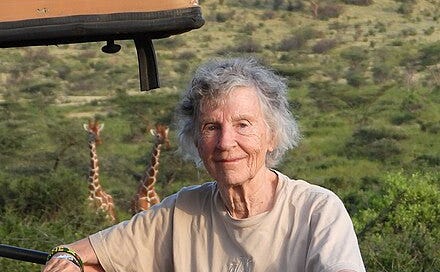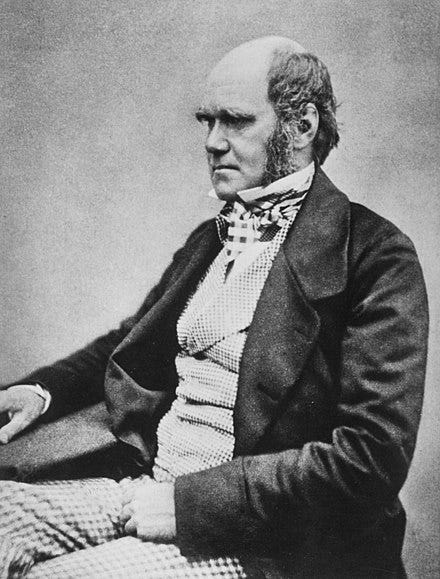#134 - Notes on Learning, Giraffes and Beagles
Education Coffee is a 2xWeekly Newsletter on People, Ideas and Culture.
Why #LearningStories?
In 2020, I started a podcast called #LearningStories to understand how people acquired a set of skills and knowledge in a creative and innovative manner. In the process I hoped to uncover a new understanding of learning as conceptualized, narrated, and imagined by our guests. I recently completed #50 episodes and you can find the archives here.
I then started writing about the #LearningStories of individuals that have inspired me over time. I know I won’t be able to interview them on my podcast, but I can research their lives and try my best to paint a portrait of how they learned and built their careers and lives over time. This a new series I hope to publish and release periodically through this newsletter. You can find other such posts in the archive section of my blog. Here is the learning story of two such individuals in the field of scientific research. I always wondered what an ideal learning environment would look like for these two individuals? Let us find out what worked for them.
Annie Innis Dagg Learning Story
Anne Christine Innis Dagg (1933 – 2024) was a Canadian zoologist, feminist, and author of numerous books. A pioneer in the study of animal behaviour in the wild, Dagg is credited with being the first person to study wild giraffes. This is her #LearningStory.
Curiosity
Anne Innis Dagg, born on January 25, 1933, in Toronto, Ontario, was profoundly influenced by her academic family and early experiences. Her father, Harold Innis, was a professor of political economy at the University of Toronto, and her mother, Mary Quayle Innis, was a writer and historian. At the age of three, during a visit to Chicago’s Brookfield Zoo, Anne became captivated by giraffes, sparking a lifelong passion. This fascination was nurtured by her parents, who provided her with books about animals, fostering her interest in zoology. Despite societal expectations, Anne pursued a career in animal studies, leading her to become a pioneering researcher in giraffe biology and behavior.
Competence
Dr. Dagg earned her Bachelor of Arts in Biology from the University of Toronto in 1955, where she developed a strong foundation in zoology. Despite facing significant gender barriers, she pursued independent research on giraffes in South Africa in 1956, making her one of the first scientists to conduct field studies on these animals in the wild—predating even Jane Goodall’s work with chimpanzees. Upon returning to Canada, she sought academic opportunities but encountered institutional resistance due to her gender. Nevertheless, she continued her studies and obtained a Ph.D. in animal behavior from the University of Waterloo in 1967, focusing on biomechanics and movement in mammals. Throughout her career, she combined rigorous scientific research with advocacy, publishing extensively on animal behavior, conservation, and gender equality in academia. Her perseverance and unconventional academic path ultimately reshaped the study of giraffes and challenged biases in scientific institutions.
Creation
Dr. Dagg’s research focused primarily on giraffe behavior, biomechanics, and conservation, making her a pioneering figure in zoology. Her groundbreaking 1956 field study in South Africa was one of the earliest scientific observations of wild giraffes, contributing significantly to the understanding of their movement, feeding habits, and social structures. She published The Giraffe: Its Biology, Behavior, and Ecology (1976), a seminal work that remains influential in the field. Beyond giraffes, Dagg researched animal locomotion, publishing studies on how mammals move and interact with their environments. She also wrote extensively on gender discrimination in academia, advocating for women in science. Her publications include over 60 scientific papers and more than 20 books, spanning topics from wildlife conservation to feminist perspectives on research institutions. Despite facing institutional barriers, her work has had a lasting impact on both zoology and the fight for gender equality in academia. Her impact on current understandings of giraffe biology and behaviour were the focus of the 2011 CBC radio documentary Wild Journey: The Anne Innis Story, the 2018 documentary film The Woman Who Loves Giraffes, and the 2021 children’s book The Girl Who Loved Giraffes and Became the World’s First Giraffologist.
Charles Darwin Learning Story
Charles Robert Darwin (1809 -1892) was an English naturalist, geologist, and biologist, widely known for his contributions to evolutionary biology. His proposition that all species of life have descended from a common ancestor is now generally accepted and considered a fundamental scientific concept. This is his #LearningStory.
Curiosity
Charles Darwin grew up in a well-to-do and intellectually stimulating environment in Shrewsbury, England. Born in 1809, he was the son of Dr. Robert Darwin, a wealthy and respected physician, and Susannah Darwin, who came from the influential Wedgwood family. His father encouraged a practical approach to education but initially viewed Charles as an unmotivated student, as he was more interested in nature than in formal studies. After his mother’s death when he was eight, Darwin was sent to Shrewsbury School, where he struggled with the rigid classical curriculum but excelled in natural history and chemistry. His father initially pushed him toward a medical career at the University of Edinburgh, but Darwin found medical studies uninspiring and instead gravitated toward natural sciences. Later, at Cambridge University, his mentor, botanist John Henslow, nurtured his scientific curiosity, ultimately setting him on the path to becoming one of history’s most influential naturalists.
Competence
Charles Darwin’s education and training as a researcher were shaped by a combination of formal studies and hands-on scientific exploration. Initially, he attended the University of Edinburgh in 1825 to study medicine, but he found medical lectures dull and was uninterested in surgery. Instead, he became involved with natural history, joining the Plinian Society, where he learned about marine biology and geological processes. Recognizing his lack of enthusiasm for medicine, his father sent him to Christ’s College, Cambridge, in 1828 to study theology with the expectation that he would become a clergyman. However, at Cambridge, Darwin was deeply influenced by botanist John Henslow, who introduced him to scientific fieldwork and encouraged his interest in natural history. His real training as a researcher came with his voyage on HMS Beagle (1831–1836), during which he conducted extensive geological, zoological, and botanical observations across South America and the Pacific. This expedition provided the foundation for his groundbreaking ideas on evolution and natural selection, shaping him into one of history’s most influential scientists.
Creation
Charles Darwin’s achievements as a researcher and writer revolutionized biology and reshaped our understanding of life on Earth. His groundbreaking work on evolution and natural selection emerged from years of meticulous research, beginning with his observations during the Beagle voyage (1831–1836). He collected extensive data on geology, fossils, and species diversity, particularly in the Galápagos Islands, which later informed his theory of evolution. His most influential book, On the Origin of Species (1859), introduced the concept of natural selection, providing a scientific explanation for how species adapt and evolve over time. Darwin continued expanding his ideas in subsequent works, such as The Descent of Man (1871), which applied evolutionary theory to human origins, and The Expression of the Emotions in Man and Animals (1872), which explored behavioral evolution. His extensive research on barnacles, plants, and animal behavior further demonstrated the interconnectedness of all living organisms. Through his rigorous scientific methodology, detailed observations, and compelling writing, Darwin transformed biology, laying the foundation for modern evolutionary science.
Notes and Links
Annie Dagg Website – https://anneinnisdaggfoundation.org/allaboutanne
Charles Darwin Profile – https://www.britannica.com/biography/Charles-Darwin
Abhishek





